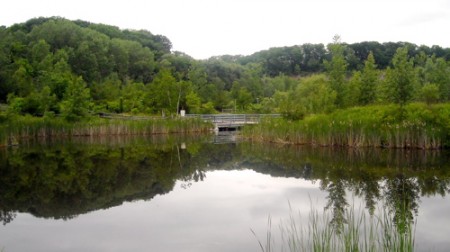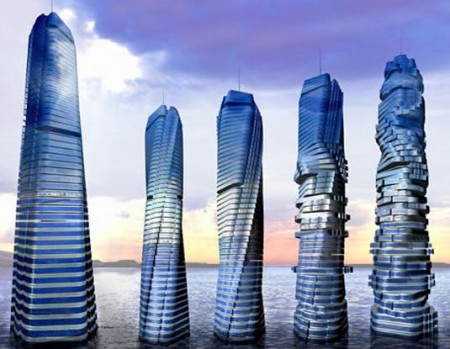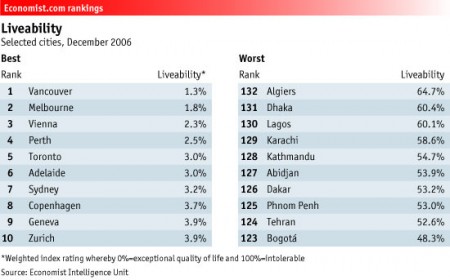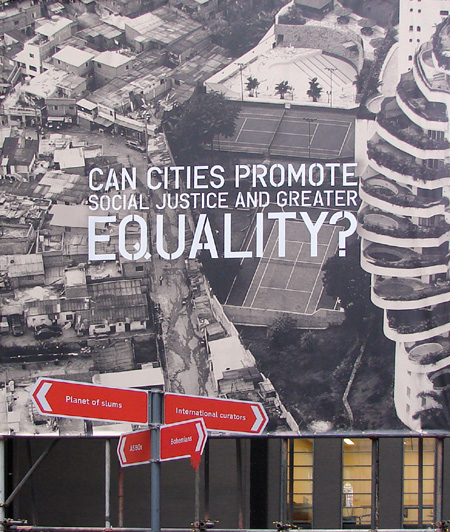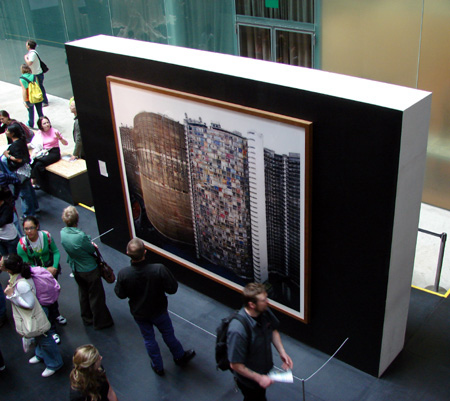
|
||
|
|
||
|
06 20
CKF Film Friday No. 4: Something Different
We are offering something different. Today’s FIlm Friday is brought to you by the Evergreen Brick Works. Evergreen is not just a variety of tree, its a grass-roots movement dedicated to making cities sustainable through the entwined forces of “Community, Culture, and Nature.” Evergreen Executive Director Geoff Cape describes it this way: “Our philosophical basis is to move society through a value change that comes with interacting with nature in a fundamentally different way.” Last night the not-for-profit organization threw a 500 person $500 a plate fundraising dinner and party on the Brick Works property near downtown Toronto. The bucolic former brick quarry was painstakingly transformed into a series of cultural moments—think passion play here but not for religion, for sustainability. The still photos included here convey something of the experience. Jamie Kennedy, a tenant of Brick Works and one of the city’s great chefs, created the evening’s meal which turned out to be more than worthy of the cause. And if you imagine the modern eco-warrior to be cast in the Paul Watson mold, well, you’ve missed the revolution. Today’s environmentalists include affluent people who are happy to donate time and money, lots of money, to a great cause. Making the Brick Works a reality is apparently at the top of their list. Interested? Here are some films about the Brickworks including a brief clip of last night’s performance.
06 10
Absurd Green Architecture In Dubai
Building in Dubai will always challenge the idea of sustainability because of the extreme temperatures and lack of water in the region. In spite of that reality, capital generated by $139 a barrel oil is making it possible for architects to try radically new, untested technologies in designs that attempt to generate more energy than they consume and in doing so achieve something that could be called sustainability. So it is with Italian architect David Fisher’s design for the green environmental tower in Dubai. Named the “Dynamic Architecture” building, the sixty storey tower is also a power source. Forty-eight 0.3 megawatt turbines are contained within its rotating floors. Fisher writes, “Considering that Dubai gets 4,000 wind hours annually, the turbines incorporated into the building can generate 1,200,000 kilowatt-hour of energy.” The architect describes three technologies that the project relies on for its success. First is the ability for architecture to be dynamic, to constantly change its form. Second, is the integration of power-generating technologies that let the building generate more power than its inhabitants consume. Third, is the factory-based construction that will reduce the number of site workers, speed construction time, and improve the final finish quality. Take a look at this rather pretentious video for an explanation of the tower. What’s my take on it? Before I was an architect I followed a Buckminster Fuller inspired career path working in aircraft manufacturing for the de Havilland Aircraft Company. I’ve seen the technologies required to make this work from both sides of the technology spectrum, and odds are that this building will fail to meet its objectives. That does not mean it is an unworthy experiment. Inventing new ways of sustainable living will not be easy or cheap; however, we have little choice but to try and if it takes $139 oil to get us there so be it.
01 04
People Oriented Cities—A Short Film
Want to know what a people oriented city looks like? Watch this film and find out. Here is a quote: “In a country where the average income is higher than that of the United States, many citizens have chosen the bicycle as their means of transportation because they live better that way.”
12 20
Greening Manhattan
A year ago I was invited to New York to take part in a discussion about the future redevelopment of Governors Island. If you have never heard of it don’t be surprised-most New Yorkers don’t know it exists either despite the fact it is just 500 metres or so from Manhattan. Well it turns out that a decision was made yesterday to enlist Toronto’s Waterfront redesign team “West 8" to work on the redesign of Governors Island. The selected vision is much the same as the one I described last year.
After my visit to Governors Island, I wrote this opinion piece for the New York Society of Urban Designers—I hope it influenced in some small way the choice of West 8’s scheme: When the Dutch came to Governors Island, they saw a land green with promise. To them, America’s pristine forests breathed opportunity. We wonder though, has Governors Island lost its symbolic promise of a better life based on the natural richness of the land? Has America? The pilgrims moved on to Manhattan but the island’s strategic location at the mouth of New York’s harbor made it an ideal military stronghold. The Coast Guard left Governors Island in 1996. Their move ended a string of military stewardships going back to before the British. In fact, the island helped save George Washington and his revolution. The old military buildings here smell of history. They became a national monument in 2001. In 2003, ownership of the Island transferred to the people of the State of New York. It awaits its next great purpose. A few hundred yards away, alone in an occasional drifting fog, stands the Statue of Liberty. Governor Island’s old flint battlements guard this symbolic gateway to America where the poor of the world came in search of opportunity. Instead of a gateway to a land green with promise, the island archipelago of New York now risks becoming a gateway to a nation in environmental decline. Even oil barons know we are at a turning point. The American continent that once nutured dreams of prosperity is in peril. Cities and their users have to change - and they know it. Can we start again – here, where we began? Can we build a sustainable America? The island could be for urban sustainability what Silicon Valley is for high technology – a center where the best and brightest gather to solve complex problems. Imagine the whole of Governors Island as a 21st century laboratory for the development of sustainable cities (and, of course, a sustainable New York). It would house a human enterprise on the scale of the Manhattan Project but dedicated to life not death. There is also the advantage of having the world’s greatest urban test-bed just across the harbor. What would it look like? When urban designers get the job of imagining a Governors Island of the future, they must acknowledge that this is not just another green-field site waiting to be planted with so much architectural stuff. These 172 acres need a grand vision. Santiago Calatrava offers one part of that vision. His scheme for a gondola system connecting the island with Brooklyn and Manhattan is the essence of innovation. In plan, the system looks like a fragile web supporting a pendulum. Maybe, figuratively, it is. Calatrava’s scheme solves the problem of transporting people to and from Brooklyn to the island quickly. It is an essential first step in the adaptive reuse of this tremendous resource. A further step might be to create a special kind of park. Imagine a place similar in scale to Chicago’s Millennium (...read more...)
08 27
Is Toronto Really The World’s Fifth Most Livable City?
The Economist city liveability rankings came out last week. You may have seen the results: Vancouver ranks number 1 and Toronto number 5. In the past I’ve had felt a certain pride with these results. After all, Toronto as a city is unique in its ability to provide a net for so many of the world’s different cultures. We also remain a relatively safe city to live in - in spite of the recently surge in killings. Even better, “Creative Class” guru Richard Florida has become a permanent resident of the city and is now a professor at the Rotman Business School. His move cuts through the deepest cynicism about Toronto’s place in the world. In spite of all this good news, I am starting to lose faith in the city. If we shift the criteria used to judge what makes a livable city then Toronto’s rating plunges dramatically. A report by the Pembina Institute will be released today criticising the city’s suburban sprawl. According to the Toronto Star’s Andrew Chung, the city ranks number one in the province in terms of its sustainability while our edge suburbs in the 905 region are the least sustainable places to live. We continue to eat up once productive farm lands in order to perpetuate unsustainable visions of the ideal Canadian lifestyle. You know what it looks like. There is the obligatory swimming pool. Three cars sit in the driveway. No one walks. Even if they wanted to walk the closest store is a kilometer away. Those areas of Toronto have populations growing at alarming speed while the so-called sustainable core of the city grew less than one percent in the last five years. Meanwhile, Toronto continues to fail in its accommodation of the city’s cyclists. This bureaucratic negligence over something so obvious and simple kills people. It also means more commuters are forced to drive to work in the city. That causes more congestion and more pollution.
Meanwhile, our federal government says there really is nothing that can be done to reduce our ever increasing production of greenhouse gasses. Cut back! Are you kidding?? We are a world leading exporter of hard to produce, oil sands derived oil. That means conforming to our Kyoto emission agreement is impossible so we won’t even try. So, let’s take a moment to review the city’s performance under these new criteria. Toronto (and Vancouver) while in the top five of the Economist’s city rankings, represent urban lifestyles that cannot be sustained in the mid to long term. We are in denial on every real measure of sustainability. We enable the unsustainability of other industrial economies by providing cheap, “externality” blind oil. Rather than celebrating our Economist ranking, Torontonians might be better off using it as a warning that dramatic action is required. If we don’t, we run the risk of quickly sliding into the world’s has-been civilizations that were promising but at some point could not do what was required to sustain themselves in spite of the reality of their finite environmental resources.
08 02
How Bogota Can Help Us Reinvent Cities For People
The former mayor of Bogota, Colombia explains how the once crime-ridden city is now a model for effective transit and urban design. How’d they do it? City planners recognized that the great battle over public space in cities is between two main forces: the needs of people and the needs of cars. In Bogota people are winning that fight. In our so-called world class city, our car-centric city administration is unable to make the hard choices required to elevate the majority’s needs over the needs of the minority of car users. Adding one kilometer of bike lanes when hundreds are required is such an affront that in a civilized city the politicians behind such a policy would soon be without jobs. My recent trip to Sweden, Denmark, France, and England revealed how much European cities are doing to promote efficient transit policies. In Gothenberg and in Copenhagen, for example, road designers seem to pay as much attention to building cycle roadways as they do building roads for cars. They are integrated and to some degree symbiotic. These are northern cities remember, they get snow just like Toronto does, yet people there cycle all year round. Still, we expect first-world, high-tech countries to embrace urban design best practices. However, when a problem plagued city like Bogota - I visited and worked there in the mid-eighties - can reinvent itself in less than fifteen years we have to ask why Toronto continues to lag so far behind.
My favourite quote from the former mayor?
That is the philosophical difference between the two cities. In Toronto we acknowledge that cars and their drivers remain the focus of our policies. Take a few minutes to listen to Mr. Peñalosa. It is worth your time. I can’t guarantee, however, that you won’t dash off a scathing letter to city hall when you are finished watching.
07 30
Can Cities Help Save Us?
Are cities the answer to the world’s population crisis? I hope so given that now more than 50% of the earth’s population is living in them. While in London last week, I visited the Tate Modern Museum to see the “Global Cities“ show. Curated by Ricky Burdett and Sheena Wagstaff, the exhibit explores what happens when rapidly expanding cities, the need for social justice, and our increasingly fragile environment intersect. The theme is powerful and the show does well at illustrating the opportunities and threats created by massive cities. The curators were able to stitch together an array of notable contributors including Zaha Hadid, Nigel Coates, and Rem Koolhaas. Their work here is strong - we expect that from these practitioners - but it is the geographer’s statictics that are the conceptual centre of the show. Did you know that there are now 20 mega-city regions with more than 10 million people each? How about that there are 450 cities with more than 1 million inhabitants? Tokyo is the world’s largest city with more than 34 million citizens but is also the best-practices model for how massive cities can remain livable. How about this stat: Six million cars operate on Sao Paulo Brazil’s streets and a thousand new cars are registered there every day. Toronto’s problems seem insignificant by comparison. Yet, the city is suffering through yet another funding crisis. The latest subway extension scheme is threatened with cancellation as a result. We don’t know how to build bike lanes as one way to reduce the need for cars (this is an embarrassment given the strides European cities have made to promote cycling that on this point alone we don’t deserve the title of world-class city). For all its promise, Toronto is losing its place as a best-practices model for the contemporary city. We still, however, can claim to offer a degree of social justice and civility that is enviable. How long wil that last without investment in our overall infrastructure? Modern cities will either liberate us or enslave us, save the environment or help destroy it. Toronto still has the potential to show the world how great a city can be but we have to invest in that positive future or risk being swept aside in a sea of urban change.
|

Contribute to the MESH Cities intelligent city database. Click here.
Read what people are saying about the environmental issues that impact us all
News about wind energy
News about green investing
Blog posts about electric cars
|
The best green news sources on the Net
Treehugger
Eco Worrier
Inhabitat
Lime
World Changing
|
